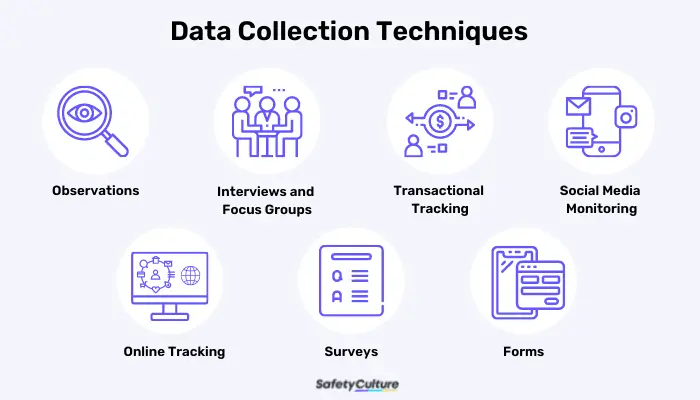What are Data Collection Techniques?
Data collection techniques refer to methods used to collect and analyze different forms of data. Standard data collection techniques include going through documents related to a topic, conducting interviews with people who know about the subject, and listing observations that can help solidify the information gathered.
Kinds of Data
Generally, data collection can yield two kinds of data: qualitative and quantitative.
- Qualitative data refers to data that describes the characteristics, qualities, and other non-quantifiable traits of a certain subject. This includes personal opinions, descriptions of a certain place, event, or behavior, or the quality of a certain item. Qualitative data is often hard to measure with numbers, and so they are analyzed based on their qualities or patterns.
- Quantitative data, on the other hand, refers to quantifiable or countable data such as statistics, the number of respondents or test subjects, and those under certain standards of measurement such as temperature.
Both quantitative and qualitative data have similar data collection techniques, as they often work together to help create a more in-depth analysis of the data.
Benefits Using Different Data Collection Methods
Data collection techniques can offer a number of benefits to businesses and organizations of all sizes, from small startups to Fortune 500 companies.
- First, they can help improve the efficiency and accuracy of data collection. This, in turn, helps reduce data errors and improve decision-making.
- They are also useful in identifying patterns, trends, and anomalies in the data obtained, thus enabling leaders to make better-informed decisions.
- Lastly, they can reduce costs associated with manual data collection. With an automated process, businesses can significantly decrease the time required to collect data.
Applications
Data collection techniques are becoming increasingly popular in various business areas. For example, healthcare institutions can utilize these techniques to collect data on patient histories, patient records, and other critical information. Similarly, they can also be used in logistics and transportation to collect data on shipments and routes for improved business operations.
Overall, data collection methods offer several benefits to businesses of all types. By deploying the right technique, they can maximize the value and insights from their data to get more from their investments in technology.
7 Data Collection Techniques

Data Collection Techniques
There are many ways to collect data depending on the data needed and the tasks at hand. Here are seven of the most common data collection techniques in business analytics as said by Harvard Business School.
1. Observations
The easiest and most direct data collection technique is observation. The most common form of observation in the context of data collection involves simply watching the behaviors or actions of a subject in a specific setting to understand them and record what was observed. In today’s online world, an example of the act of observation can include watching people interact with products, websites, and services in real-time.
2. Interviews and Focus Groups
Another direct data collection technique is conducting interviews and focus groups. A focus group is a kind of interview-like conversation that happens in a group of six to twelve people who share a common interest, characteristic, or need. The group will have a facilitator present them questions to discuss together. The aim of having an interview and a focus group discussion is to gain more information and depth on different topics, perceptions, beliefs, and attitudes in an environment where they all come together.
This data collection technique can become more streamlined with the help of a focus group template.
3. Transactional Tracking
Transactional tracking is a data collection technique that relies on one’s purchases to derive data from. With each purchase made by a customer, researchers and sellers can access data from their websites, a third-party service provider, or from their e-commerce in-store point of sale system. From there, they can track different forms and amounts of data, allowing them to create better marketing plans and products, and target their ideal customers. Tracking customers’ transactions is also a good way to know and understand them better, as their purchases can say a lot about them.
4. Social Media Monitoring
Social media monitoring is a data collection technique similar to transactional tracking. However, instead of a customer’s transaction history, this kind of technique focuses on tracking one’s social media history and footprint. Many platforms and businesses use this to track one’s engagement with different posts online to better understand what products and services they would be interested in, as well as what they consider important to them. From this, businesses can better target their customers with more fitting advertisements and more relevant products.
5. Online Tracking
Another data collection technique similar to transaction tracking and social media monitoring is online tracking. Unlike the other internet-based data collection techniques, online tracking is more general and can be done on sites other than e-commerce or social media ones through the use of cookies. Through online tracking, data can be collected from marketing campaigns run through search engine results, webpage advertisements, email campaigns, and other places where one’s brand can be showcased. As long as it is online, it can be tracked.
To successfully carry out online tracking as a data collection technique, one would need to have specific software to help them analyze the numbers and behaviors of their customers online. Some things this kind of software dedicated to online tracking can tell are the number of times a certain link is clicked, the device used by customers, ads clicked, location, and more.
6. Surveys
Surveys are one of the most well-known methods of data collection. They are done with questionnaires and can be conducted physically and digitally to collect both quantitative and qualitative data. These questionnaires are often inexpensive to create and answer, thus making surveys a very accessible option for both researchers and their correspondents.
Commonly, surveys are used to collect responses about an event or item. The responses collected can then be used as a basis for product improvement, decision-making matrices, or further studies.
7. Forms
Similar to surveys, forms try to gather data through a set of questions. However, unlike surveys, forms can be more general. Often, forms are used to gather qualitative data from a subject or a group of subjects, particularly their demographic data or contact details. Forms are also used to get in touch with one’s potential clients and get to know them better.
How to Make Effective Use of Data Collection Methods
When it comes to using data collection techniques effectively, there are 5 key steps to keep in mind:
1. Identify the Audience and Type of Data to be Collected.
First and foremost, it is important to define the target audience and determine the specific data that needs to be collected. This will allow the data collection technique to be as applicable as possible to provide the most accurate results.
2. Map the Data Collection Process.
Once the target audience and data have been determined, plan out the data collection process. When setting up a data collection technique, it is essential to ensure that the method is comprehensive and can account for any data that may be missing.
Additionally, a data collection technique should consider how the data will be collected, and how the data can be interpreted and used effectively.
3. Analyze the Results.
When the data has been collected and all steps have been taken to ensure accuracy, it is important to analyze the results.
4. Observe the Relationship Between Data Points.
Once the analysis is complete, it is possible to see how the data is related to each other and determine the answers to any questions posed by the data. By understanding the relationships between different data points and the trends that they indicate, effective decisions can be made.
5. Communicate Your Findings.
Lastly, it is essential to effectively communicate the data collection technique findings. By clearly communicating the results, the gathered insights can be used to solve real-world problems, make informed decisions about a business or organization, or even just learn and better understand how things work.




